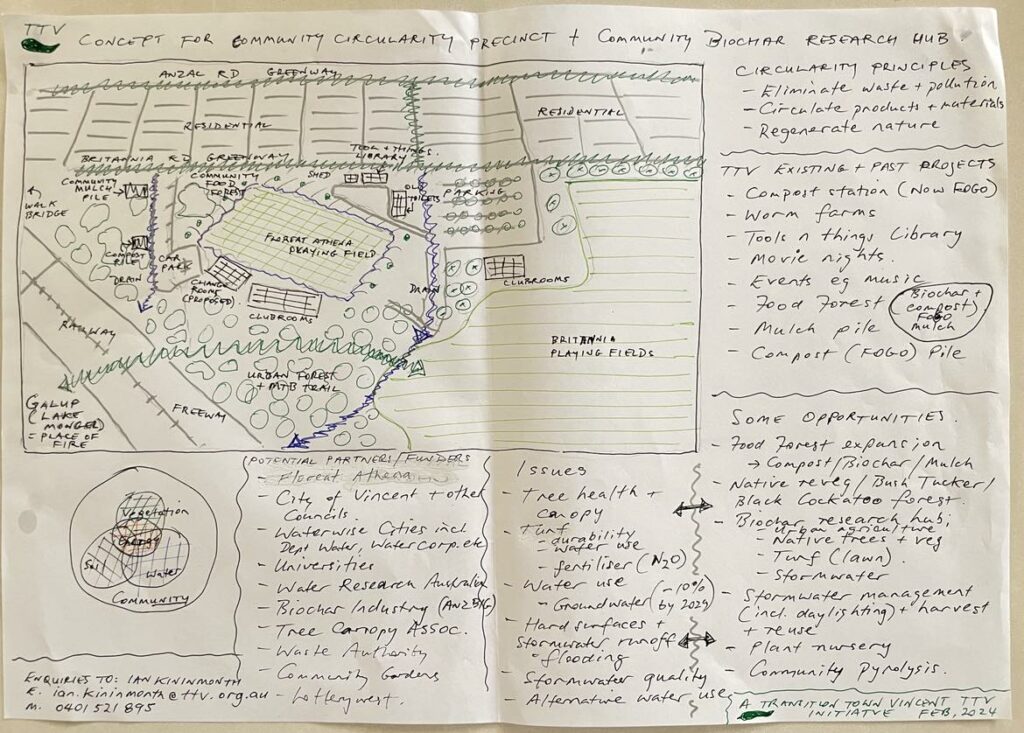Community Circularity Precinct
The concept for a community circularity precinct and community biochar research hub is designed to build on the existing strengths and opportunities which exist in the area to address relevant local issues using a circularity approach. 
Circularity principles include:
- Eliminate waste and pollution.
- Circulate products and materials.
- Regenerate nature.
A fourth principle is to keep it local.
Some issues pertinent to the site and surrounding area include:
- Tree and vegetation cover:
- Water use / drought tolerance.
- Canopy coverage.
- Vegetation health.
- Hard surfaces and stormwater runoff.
- Urban heat island.
- Lack of infiltration.
- Wasted resource.
- Water quality.
- Turf (including playing fields and lawns):
- Durability/trafficability.
- Water use.
- Use of chemical fertilisers.
- Water use:
- Groundwater allocation reducing by 10% by 2029.
- Hotter, drier climate resulting in higher water demand.
- Soils have poor water holding capacity., fertility, repellant.
- Stormwater quality.
- Alternative water use e.g. grey water.
- Waste management
- Green waste streams exported form the area along with nutrient and carbon.
- Energy use:
- Use of trees for shade, cooling.
- Use of renewables.
Some of the strengths of the existing area include:
- Proximity to local residents who participate in TTV activities and projects.
- Knowledge about biochar, composting and worm farming.
- Tools n things library.
- A venue for conducting movie nights and other .
- Food forest established with biochar, FOGO compost and worm juice.
- Mulch pile.
- FOGO compost pile.
Some opportunities for strengthening the circularity precinct:
- Working to increase the soil organic carbon (currently estimated at only less than 1% – compared to Kings Park which is about 3%) and provide other benefits e.g. water holding capacity using a regenerative approach which focuses on the three key components of soil organic carbon being resistant carbon (e.g. biochar/charcoal), humus (e.g. compost, worm castings) and particulate carbon (e.g. soil organisms).
- Using a circular/regenerative approach to develop the primary soil organic carbon constituents e.g. biochar, compost, soil organisms.
- Expanding the food forests using locally produced or sourced biochar, compost and microbes.
- Restoring native habitat by revegetating with native plant species and increasing the tree canopy to provide shade and biomass. See Black Cockatoo Forest initiative.
- Managing wasted water resources e.g. stormwater, grey water, rainfall more sustainably, including through water harvesting and reuse, daylighting of stormwater drains and developing biochar trenches and wells.
- Establishing a plant nursery.
- Applying the opportunities above to new development e.g. new buildings, refurbishment of existing. This includes the Tools n Things Library which is at capacity.
- Developing a community biochar research hub focusing on:
- Urban agriculture.
- Native trees and revegetation.
- Turf (lawn).
- Stormwater and grey water management.
- Partnering with research institutions to undertake research and trial the above.
Resources:
See Green Industries SA https://www.greenindustries.sa.gov.au/community-circular-hubs
Contact:
